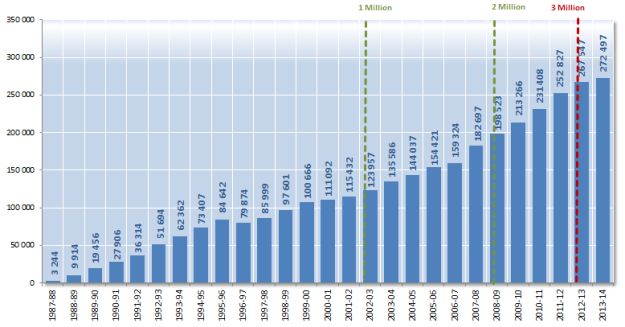Analytics, Education and Science, EU – Baltic States, Society
International Internet Magazine. Baltic States news & analytics
Friday, 26.04.2024, 02:52
The Erasmus+ programme: a year after
 Print version
Print version |
|---|
The Erasmus+ programme aims to support the modernisation of Europe's education, training and youth systems while improving students' skills, employment prospects and their active participation in society.
The seven year programme (2014-20) has a budget of €14.7 billion - a 40% increase compared to previous spending levels, reflecting the EU's commitment to invest in these areas. It combines seven previous programs into one single, bigger and more coherent programme structure.
See: LLP, Youth in Action, Erasmus Mundus, Tempus, Alfa, Edulink, Higher education cooperation programmes with industrialised countries.
The programme also supports transnational partnerships among education, training and youth institutions to foster cooperation and bridge the worlds of education and work. For the first time, the programme also offers dedicated funding for actions in the area of sport to contribute to developing its European dimension and tackle major cross-border threats such as match fixing and doping. The programme also supports the development of teaching and research on European integration through Jean Monnet actions.
The main report offers the first results one year after the start of the Erasmus+ programme. It assembles data gathered by the Commission, as well as the National Agencies and relevant Executive Agencies in charge of implementing the programme.
In addition, the two other reports provide insight into the last year of the Erasmus programme for higher education. They also offer a regional perspective on the program's impacts.
Three reports
The Commission published three reports (Brussels, 26 January 2016) on EU funding in the area of education, training, youth and sport:
· A report on the first year of implementation of Erasmus+, the EU funding programme for education, training, youth and sport between 2014-2020;
· Statistics on student and staff mobility numbers in the last academic year under the former Erasmus programme for higher education.
· A follow-up to the Erasmus Impact Study - focusing on regional analysis of the benefits of the Erasmus programme.
Final year of the former Erasmus: Student and staff mobility in 2013/14
As a separate report, the Commission published new figures on the last academic year (2013/14) of the previous Erasmus programme, which covered higher education mobility and cooperation projects under the former Life Long Learning programme (2007-2013), now incorporated into Erasmus+.
Note: some figures for higher education mobility actions under Erasmus+ will become available later this year.
The findings show that in its last academic year, a record number of people benefitted from an Erasmus grant, with 272,497 students, including more than 60,000 trainees, and 57,488 higher education staff receiving funding for studies, training, job placements and teaching or training abroad. This also represented a 2% increase compared to the previous year (see table below).
Most countries participating in Erasmus (EU states, Iceland, Liechtenstein, Norway, Switzerland, Turkey and the former Yugoslav republic of Macedonia) saw increases in the number of Erasmus students going abroad (see table below) in the final year of the programme. Decreases experienced by some countries can however be explained by different reasons, including drops in student population numbers, overall national co-funding budgets or an increase in the average Erasmus grants.
In 2013/14, the most popular destination countries for students remained Spain, Germany and France (39,277; 30,964 and 29,621 incoming students respectively). The same countries also sent the most students abroad, with Spain sending 37,235; France 36,759 and Germany 36,257 students.
The number of teachers and staff going on educational exchanges grew by 9% compared to the previous year. This includes a growing number of people from companies invited to undertake teaching assignments at higher education institutions abroad, which grew in popularity by 17% on the year before. The top sending countries were Poland (7,178), followed by Turkey (5,838) and Spain (5,727). The top destination for staff mobility was Spain (5,701), followed by Germany (5,101) and Italy (4,860).
In addition to mobility grants, the Erasmus programme (2007-13) also supported cooperation projects to modernise European higher education and develop innovative education policy tools. In addition, interest in such cooperation projects grew year-on-year, with 311 applications submitted in 2013 (up from 250 in 2012). Finland submitted the highest share of all proposals (13%), followed by Belgium (12%), Spain (11%) and the UK (10%). Belgium was also the most successful in terms of applications approved with 15 projects accepted – a 19% share of the 79 funded projects in total.
The Erasmus+ programme: educational cooperation
In its first year (2014), Erasmus+ has already proved that the programme is living up to expectations. Just over €2 billion were distributed in 2014 to support actions in education and training (69% of the budget), youth (10%) and sport (1%), as well as the other actions covered by the programme.
In 2014, the programme already offered about 650.000 individual mobility grants for people to study, train, work or volunteer abroad. These included 400.000 higher education and vocational students' exchanges, 100,000 volunteers and young people undertaking youth work abroad, as well as 150,000 teachers, youth trainers and other staff who gained mobility grants for their professional development. In addition, 11 new Joint Master degrees were set up with non-EU countries within the first year of Erasmus+, to be added to some 180 Joint Master degrees and Joint Doctorates already available previously under Erasmus Mundus.
The programme is also continuing to improve the experience of its beneficiaries: more students can now be sure that the qualifications obtained abroad will be recognised in their home countries (85% in 2014, up from 76% in 2013). In order to make the programme more open and inclusive, more than 10,000 students and 50,000 young people with fewer financial means and/ or special requirements have already received additional financial support to participate in mobility actions. Furthermore, to improve the language skills of Erasmus beneficiaries, a new linguistic support tool has also been made available at end of 2014 and benefitted over 120,000 participants in this first year.
Erasmus+ also provided funding opportunities for over 1700 cooperation projects across the education, training and youth sectors, addressing key challenges such as early school leaving, the need to equip young generations with digital skills, and promoting tolerance and intercultural dialogue. Encouraging a cross-disciplinary approach, the programme also supported cooperation projects among higher education institutions and enterprises ("knowledge alliances"), vocational study and training institutions with enterprises ("sector skills alliances") and initiatives to strengthen education systems in developing countries ("capacity building projects").
As a novelty, Erasmus+ also introduced funding opportunities for policy support actions to tackle some of the key challenges to Europe's education, training and youth systems in innovative ways. In 2014, several projects were pursued with the involvement of public authorities, international organisations like the Council of Europe and OECD as well as platforms and networks of stakeholders across these sectors to address issues like early school leaving, human rights and citizenship education, youth participation, social inclusion of minorities, as well as improving teaching practices and apprenticeship training.
In addition, Erasmus+ also for the first time funded activities in the field of sport, supporting about 50 not-for profit sport events, collaborations between sports bodies and grass-roots organisations as well as the first ever EU Sport Forum.
The programme also continued to fund Jean Monnet Actions, with 212 projects supported to improve the excellence of European Studies programmes.
EU Commissioner for Education, Culture, Youth and Sport, Tibor Navracsics underlined that during the first year Erasmus+ has proved a true success. The impressive number of participants is proof that the programme is making a difference in improving young people's employment prospects, helping to acquire new skills and experiences and supporting the modernisation of Europe's education, training and youth systems.
He stressed that the EU will continue to build on
this popularity to reach out to more people with different interests, profiles
and social backgrounds.
 |
| Table: increases in the number of Erasmus students going abroad |
Erasmus Impact Study: regional analysis
The Regional Impact Analysis of the Erasmus programme follows and builds on the Erasmus Impact Study published in 2014, which looked at the impact of Erasmus student mobility on participants' skills, employment prospects and career paths. The new regional study brings an additional regional focus to the same data.
While the 2014 study found that Erasmus students are half as likely to experience long-term unemployment compared to those that do not go abroad, the new Regional analysis confirms that students from Eastern Europe are 83% less likely to experience long-term unemployment if they have taken part in Erasmus. Similarly, traineeships and work placements have a positive impact on finding a job – but this seems to be particularly valuable for students from countries in Southern Europe like Italy and Portugal, where half of those training abroad were offered a position by their host company.
Overall, Erasmus students are not only more likely to be employed, but also more likely to secure management positions. On average, 64% of Erasmus students, compared to 55% of their non-mobile peers hold such positions within 5-10 years from graduation. This holds even more true for Erasmus students from Central and Eastern Europe, where around 70% of them end up in managerial jobs.
Reference: http://europa.eu/rapid/press-release_MEMO-16-143_en.htm?locale=en
The new Erasmus+ is also more open, with a strong focus placed on promoting social inclusion, active citizenship and tolerance. To achieve this, more financial support than ever has been made available to participants with fewer financial means or those with special needs. A further €13 million has also been committed for 2016 to fund projects tackling issues like social inclusion of minorities and migrants and other disadvantaged social groups.
The programme has also strengthened initiatives to improve young people's employment prospects and facilitate their transition from education to work. This has seen an increase in traineeship and apprenticeship opportunities in the programme.
Table: Erasmus student mobility (2013-14) in the Baltic States
Sending Country 2012-13 2013-14 Year-on-year growth
Germany (DE) 34.891 36.257 3,92%
Denmark (DK) 3.646 3.710 1,76%
Estonia (EE) 1.153 1.010 -12,40%
Finland (FI) 5.496 5.569 1,33%
Lithuania (LT) 3.529 3.423 -3,00%
Latvia (LV) 2.149 2.185 1, 68%
Poland (PL) 16.219 15.521 -4,30%
Sweden (SE) 3.728 3.720 -0,21%
Total for EU & EEA 267.547 272.497
More information on the theme:
= Erasmus+ Factsheet; = MEMO/16/143; = Country Factsheets Reports; = Erasmus+ website.
Reference: http://europa.eu/rapid/press-release_IP-16-141_en.htm.








 «The Baltic Course» Is Sold and Stays in Business!
«The Baltic Course» Is Sold and Stays in Business!

